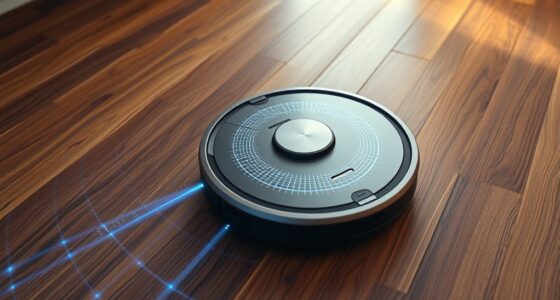Ensuring devices work together can be challenging because of incompatible standards and protocols. You may encounter data transfer errors, limited functionality, or need multiple adapters. To overcome this, prioritize devices that support common protocols like USB, Bluetooth, or Wi-Fi, and research their specifications beforehand. Using translation layers or middleware can also help bridge gaps. Staying aware of evolving standards keeps your systems running smoothly. Continue exploring to discover more ways to simplify device interoperability effectively.
Key Takeaways
- Compatibility issues arise from incompatible data formats and communication protocols, hindering seamless device integration.
- Proprietary protocols and multiple standards increase system complexity and complicate interoperability efforts.
- Conformance testing ensures devices meet industry standards, reducing troubleshooting and communication failures.
- Using translation layers or middleware can bridge incompatible standards, facilitating device communication.
- Proactive research, standard adherence, and ongoing awareness of evolving protocols support effective device interoperability.

Interoperability challenges arise when different systems, devices, or software fail to communicate effectively, hindering seamless data exchange and collaboration. At the core of these challenges lies device compatibility—ensuring that various hardware and software components can work together without issues. When devices aren’t compatible, you might find yourself struggling with data transfer errors, limited functionality, or the need for multiple adapters and workarounds. To overcome this, you need to focus on establishing standards alignment, which involves adhering to common protocols and specifications that promote interoperability. Without standards alignment, devices from different manufacturers may use incompatible data formats or communication protocols, making integration difficult or even impossible.
Device compatibility and standards alignment are essential for seamless interoperability and effective data exchange.
Device compatibility is often the first obstacle you encounter. For example, connecting a new printer to your existing network can become a headache if the printer isn’t compatible with your operating system or network protocols. This incompatibility can lead to frustration, delays, or even the need to replace hardware entirely. To mitigate this, it’s vital to check device specifications and ensure they support widely accepted standards before making a purchase. When devices follow standard protocols—like USB, Bluetooth, or Wi-Fi—they are more likely to work smoothly with other systems, reducing the chances of incompatibility issues. Additionally, understanding conformance testing can help verify whether devices meet industry standards and work together properly.
Standards alignment plays a significant role in fostering interoperability across different devices and platforms. When manufacturers agree upon and implement common standards, you benefit from a more seamless experience, with devices communicating effortlessly regardless of brand or model. This alignment simplifies integration, reduces troubleshooting, and increases reliability. However, the landscape is often complicated by the existence of multiple standards or proprietary protocols. In such cases, you may need to use translation layers or middleware that bridge incompatible standards, adding complexity and latency to your system.
Achieving effective interoperability requires ongoing attention to device compatibility and standards alignment. It’s not enough to simply select hardware based on features; you must also verify that they support compatible standards and protocols. By prioritizing these aspects, you can avoid costly delays and ensure your devices work together harmoniously. In the end, the key is proactive planning—researching device specifications, understanding the standards in use, and choosing solutions designed with interoperability in mind. Doing so will save you time, money, and frustration, enabling smoother data exchange and more efficient collaboration across your digital ecosystem.
Frequently Asked Questions
How Do Manufacturers Address Proprietary Technology Barriers?
Manufacturers address proprietary technology barriers by adopting open standards and supporting proprietary protocols that promote compatibility. They often develop universal APIs and collaborate with other vendors to reduce vendor lock-in, allowing devices to work seamlessly across different systems. By embracing interoperability, they guarantee their products can integrate smoothly, giving users more flexibility and choice, while also fostering a competitive ecosystem that benefits everyone involved.
What Role Does Standardization Play in Device Interoperability?
Think of standardization as the Rosetta Stone for device communication. It plays a pivotal role in device interoperability by establishing common communication protocols and data formats, allowing diverse devices to understand each other effortlessly. When manufacturers adopt these standards, devices can share information seamlessly, much like different languages translating into a universal tongue. This reduces compatibility issues and accelerates innovation, making your connected experience smoother and more reliable.
How Can Consumers Improve Device Compatibility at Home?
You can improve device compatibility at home by choosing products with user-friendly interfaces, making setup and daily use easier. Keep yourself informed through user education, such as online tutorials or manuals, to understand how devices connect and troubleshoot issues. Regularly update firmware and apps, and stick to brands that prioritize interoperability. This proactive approach guarantees smoother integration, enhancing your smart home experience and reducing frustration with incompatible devices.
What Are the Cybersecurity Risks Associated With Device Integration?
Like trusting a vintage radio to connect seamlessly, integrating devices today presents cybersecurity risks. You risk unauthorized access if you neglect proper device authentication, which verifies devices before sharing data. Weak data encryption can expose your personal info to hackers. To stay protected, guarantee your devices use strong authentication and encryption methods, just like updating old tech with modern security patches, safeguarding your smart home from cyber threats.
How Does Interoperability Impact Device Maintenance and Updates?
Interoperability makes device maintenance and updates more complex because you need to address firmware updates across different systems. Compatibility issues can cause delays and require additional troubleshooting, meaning you spend more time ensuring all devices stay current and function properly. You might also face challenges when updating firmware, as some devices may not support the latest features or updates, leading to potential security vulnerabilities or performance problems.
Conclusion
Just like a symphony relies on each instrument harmonizing perfectly, achieving device interoperability requires seamless cooperation. When devices sync smoothly, they become a unified orchestra, creating a flawless performance. But ignoring these challenges risks dissonance and chaos, like a broken instrument in the ensemble. Embrace these hurdles as opportunities to fine-tune the harmony, so your technology can sing in perfect unison—turning complexity into a beautiful melody of innovation.








